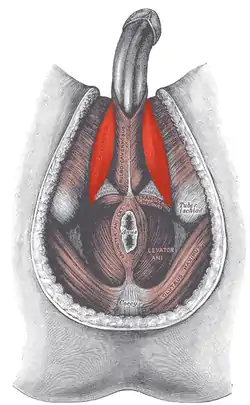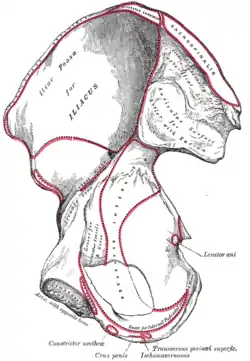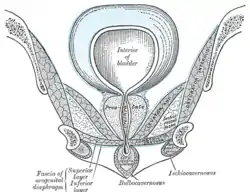Ischiocavernosus muscle
The ischiocavernosus muscle (erectores penis in older texts) is a muscle just below the surface of the perineum, present in both men and women.[1]
| Ischiocavernosus muscle | |
|---|---|
 Muscles of male perineum (ischiocavernosus visible at upper left) | |
 Muscles of the female perineum (ischiocavernosus visible at upper right) | |
| Details | |
| Origin | Ischial Tuberosity |
| Insertion | Crus of penis |
| Artery | Perineal artery |
| Nerve | Pudendal nerve |
| Actions | Assists the bulbospongiosus muscle (in males, empties the urethra; in females, clenches the vagina) |
| Identifiers | |
| Latin | musculus ischiocavernosus |
| TA98 | A09.5.02.004 |
| TA2 | 2417 |
| FMA | 19730 |
| Anatomical terms of muscle | |
Structure
It arises by tendinous and fleshy fibers from the inner surface of the tuberosity of the ischium, behind the crus penis; and from the inferior pubic rami and ischium on either side of the crus.
From these points fleshy fibers succeed, and end in an aponeurosis which is inserted into the sides and under surface of the crus penis.
Function
It helps (in males) stabilize the erect penis and (in females) tense the vagina during orgasm.
Ischiocavernosus compresses the crus penis, and retards the return of the blood through the veins, and thus serves to maintain the organ erect.
Additional images
 Right hip bone. Internal surface.
Right hip bone. Internal surface. Coronal section of anterior part of pelvis, through the pubic arch. Seen from in front.
Coronal section of anterior part of pelvis, through the pubic arch. Seen from in front. The superficial branches of the internal pudendal artery.
The superficial branches of the internal pudendal artery.
References
This article incorporates text in the public domain from page 428 of the 20th edition of Gray's Anatomy (1918)
- Maclean, Allan; Reid, Wendy (2011). "40". In Shaw, Robert (ed.). Gynaecology. Edinburgh New York: Churchill Livingstone/Elsevier. pp. 599–612. ISBN 978-0-7020-3120-5; Access provided by the University of Pittsburgh
External links
- Anatomy photo:41:11-0101 at the SUNY Downstate Medical Center - "The Female Perineum: Muscles of the Superficial Perineal Pouch"
- Anatomy figure: 41:05-01 at Human Anatomy Online, SUNY Downstate Medical Center - "Muscles of the female superficial perineal pouch."
- Anatomy figure: 42:04-01 at Human Anatomy Online, SUNY Downstate Medical Center - "Muscles of the male superficial perineal pouch. "